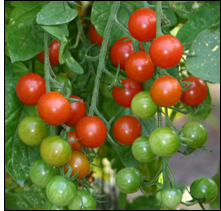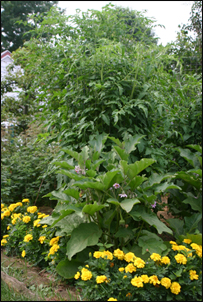![]()
FIRST VEGETABLE GARDEN
RAIN GARDENS
THE OZ VICTORY GARDEN
GARDENING TO SAVE MONEY
INCREASE YOUR BOTANY SAVVY
TILLING VS CULTIVATING
THE PERILS OF PEAT
THE DIRT ON SOIL
TINES, TINES, TINES
WHY AND HOW TO TILL
RENT OR BUY
HOW TO RENT & USE A BACKHOE
FALL LANDSCAPING TIPS
ECO FRIENDLY TIPS
USING GOOD PESTS TO FIGHT BAD PESTS
BUYING A LAWN MOWER?
TILLER CARE
COMPOSTING 101
MY NEW TILLER
AWARENESS WEEK
![]()
INTRODUCTION
SMALL TILLERS
MEDIUM TILLERS
LARGE TILLERS
HAND CULTIVATORS
WEBSITE REVIEWS
![]()
ABOUT THIS SITE
CONTACT OZ
CONTRIBUTION
JOIN THE DISCUSSION
RECOMMENDED READING
THE OZ BOOK STORE
Your First Vegetable GardenIf this is the year for your first vegetable garden, congratulations! You’re about to embark on a wonderful venture of discovery and fun. You may have some setbacks, Even very experienced gardeners do, but most setbacks are very minor in comparison to the rewards that most of us get from gardening. |
 |
Here are my suggestions for all you starting out this year |
|
Start Relatively Small
For most beginners, smaller is better. Unless you have recently retired, finally quit playing golf or some other time-consuming hobby, or if for some other reason you have a lot of time and want to spend it outside, start small. A 100 square foot garden, say 10 feet by 10 feet, will provide you with ample space to experience the joys of gardening without overwhelming you. Of course, you can start with even less space, even a 4 ft. by 5 ft. garden can be quite productive and fun. Heck, you can even start your first vegetable garden in a few containers on your deck or patio.
The Basics
No matter what size garden you’re planning, there are several basic requirements. The basics include: good soil, seeds and/or plants, water, fertilizer, weed and bug control.
Good Soil
All good gardening starts with good soil. If you’re blessed with good soil, wonderful. If not, I can help you make it better. Good soil contains a mixture of small and large mineral particles, organic materials, air, water, and millions of living organisms, from microorganisms to worms. If the mineral particles are very small, you’ll have clay soil, which can make gardening difficult. On the other extreme, soil that consists mainly or entirely of large mineral particles is sandy soil, which is also a difficult medium in which to grow. If you have either extreme, the best solution is to add compost or to purchase top soil, and till it into your soil. Rent or borrow a mini-tiller, like the Mantis tiller, to do this most effectively. Many rental stores have mini-tillers; and, chances are that a friend or neighbor might already own one.
For a more thorough discussion of garden soil, see The Dirt on Soil, elsewhere on this site.
When You Should Start
Ideally, you should start to prepare your soil a couple of weeks prior to the best planting time for your area. The best planting time for most crops is just after your last frost date. For us in Zone 6, our last frost date is usually around April 30th. Depending on where you live, your last frost date may be sooner or later. Here’s a good reference to estimate your last frost date http://www.victoryseeds.com/frost/
However, you really can start almost anytime after your last frost date. If you start in the mid-summer, for example, you can still have a garden, but you’ll be limited in what you can plant.
Seeds and Plants
My first rule for vegetable gardening is to grow what you’ll eat. By that I mean that you should only grow vegetables that you enjoy eating, and, more importantly, grow the right quantity. Many beginners have quickly learned that a half dozen zucchini plants can quickly produce more squash than they and all their friends and relatives can handle! And, most of us just don’t like to waste food. So, grow the things that you like, and start with smaller quantities. The exception here is that some folks may want to intentionally grow a lot of vegetables if they’re sure that they can either preserve the excess or share the harvest with friends and neighbors.
Here’s My Recommended List for Beginners
Tomatoes
Two beefsteak plants will provide a lot of tomatoes for sandwiches, salads, and spaghetti sauces. One cherry tomato plant will provide hundreds of little tomatoes for snacking and for salads. They can be purchased at garden centers, nurseries, home stores, and even some supermarkets.
Lettuce
Leaf lettuce is easy to grow, especially early and late in the season. Some leaf lettuce will quickly bolt (get big and produce seed) and get a little bitter in the hot summer.
Spinach
Spinach is easy to grow, very nutritious, and is somewhat more heat tolerant than lettuce.
Bush Beans
Beans are easy to grow and very nutritional. The large seeds are easy to handle.
Summer Squash
A multitude of varieties exist, and all are easy to grow. Options range from buttery yellow varieties of squash and zucchini to the traditional green zucchini. Remember, just plant a few – they’re very prolific. And, pick ‘em when they’re small. Some zucchini can grow to the size of baseball bats, but they’re not very tasty when they’re that big.
Beets
This root crop is also easy to grow and good for you. Beginners need to be reminded that it is essential to thin the young seedlings so that the remaining plants have enough room to develop.
WaterGarden plants, like all living things, need water to survive and grow. All plants get most of their food by absorbing water and dissolved nutrients through their roots. (Some plants can be “foliar fed” by spraying nutrients on their leaves, but, generally, root feeding is much more common, and more natural). A good rule of thumb is that the garden (and your lawn) should have about 1” of rainfall or watering per week. You can reduce the amount of soil moisture lost to evaporation by adding a layer of mulch to the top of your garden soil. Grass clippings, shredded dry leaves, hay and straw are excellent natural mulches. |
 |
Fertilizer
All plants, like people, need food. If your soil is very healthy, it already contains most of the food that your plants will need. A well-balanced organic fertilizer can be added when you plant, and throughout the season. Organic fertilizers break down slowly, providing your plants with a steady nutrient source. Be very careful if you use commercial or chemical fertilizers; it’s easy to overdo it. Too much chemical fertilizer will actually kill your plants. This “overfeeding” is often called “burning” the plants. (Many chemical weed killers work by over-stimulating plants so that they “grow themselves to death.”)
Of course, the best long-term solution for creating healthy, vital soil is to continuously add compost. If you find that you really like the gardening hobby, you’ll probably want to start your own compost pile, if you haven’t already. For lots of practical information on composting, see Composting 101 on this site, or visit HowToCompost.org.
Weeds and Bugs
If you garden, you’re going to encounter weeds and bugs. The best treatment for weeds is prevention, lots of mulch will significantly reduce weed growth. Just be sure that your mulch doesn’t prevent water from penetrating into the soil.
The issue of bugs is more complex. Some bugs are good, some are bad. The best overall solution is to spray a natural pesticide that will attack the bad bugs without killing the good bugs. My favorites are Pyola® and Bulls-Eye™; both are environmentally responsible and available from Gardens Alive!
If you have any comments, I’d really like to hear from you.
OZ Gardener
The Garden Of Oz
Feel free to share this article however it has to be copied and published the same way as on this website, without any changes and please include a link to the original material.
Reviews
Read Reviews (11)Write a Review
Avg Rating:

4.9 out of 5
 January 5, 2013
January 5, 2013By: Joan Cary
Hi, I started a compost pile for the first time and really enjoy feeding it and watching the stuff turn to dirt. We have a big round spot of no grass and compact soil in our back yard. Will till this area and work in the compost for better soil then plant a 8x8 section of it for garden. at the end of the season, I may just plant grass seed. Your article is right on. Thanks so much
 May 17, 2012
May 17, 2012By: Darryll
Great info....ready to get going with my new retirement hobby...
 June 28, 2011
June 28, 2011By: Branden
Good stuff!
 March 24, 2011
March 24, 2011By: Annie
Thanks! My parents are living with me at my home in PA. Their home in FL had a vegatable garden and they want one at my house also. My mother thought that this would be a good bonding expierence at her age of 60. This has helped inform me about most of the main things I need to know about gardens, and we are starting one about a month from now.
 September 16, 2010
September 16, 2010By: Dave
Love it!
 June 2, 2010
June 2, 2010By: Jill
Just planted my very first garden this weekend. Great info!
 May 11, 2010
May 11, 2010By: Susan
Thank you! My first garden is patiently awaiting something and this article may have helped me figure out what that is :)
Definitely sharing with some friends who are also just getting into the veggie scene.
 April 25, 2010
April 25, 2010By: Liz
Hi! A friend just passed along this site - after reading just a few articles, I feel like I've learned something already :) I'm starting off a veg. garden this year. I'm wondering if you know of anywhere that I can find information on how tall plants get (so I know how to map out the garden) or how many each seed yields (kind of like your information on the tomato plants above). Thanks!
 March 28, 2010
March 28, 2010By: Nick
Hi, thanks for the tips, I'll be starting off this season.
 August 7, 2009
August 7, 2009By: Rose
I did as you said and got great results. I'm wnjouing the fruits of my labor tonight for dinner.
Thaks Oz
 June 1, 2009
June 1, 2009By: Donald
I'm starting my first vegetable garden this year.
Thanks for the helpful and inspirational gardening tips

